Emmanouil Argyropoulos
Emmanouil Argyropoulos (Greek: Εμμανουήλ Αργυρόπουλος; 1889 – 4 April 1913) was a Greek pioneer aviator of the early 20th century. Apart from being the first Greek aviator who performed a flight over his homeland, he also became the first casualty of Greek military aviation.[1]
Emmanouil Argyropoulos | |
|---|---|
 E. Argyropoulos and his Nieuport IV.G aircraft | |
| Born | 1889 |
| Died | 4 April 1913 (aged 23–24) |
| Cause of death | Plane crash |
| Nationality | Greek |
| Known for | First Greek aviator, first casualty of Greek Military Aviation |
| Aviation career | |
| Air force | Greek Military Aviation Service |
| Battles | First Balkan War |
| Rank | First Lieutenant |
First flight in Greece
Argyropoulos, originally a civil engineer, abandoned his profession and went to Paris in order to study aeronautics.[2] At the end of January 1912, he acquired his pilot license and returned to Greece together with a privately owned Nieuport IV.G 50-hp aircraft. On 8 February 1912, Argyropoulos became the first Greek aviator to perform a flight in Greece, an event that was widely commented upon in the local press.[2] After taking off from the Rouf district of Athens, he performed a 16-minute-long flight around the city, including an overflight of the Acropolis. An hour later he carried out a second flight, this time with Prime Minister Eleftherios Venizelos as his passenger. Venizelos, was enthusiastic about the concept of aerial warfare, and stated that Greece should immediately take advantage of this newly invented weapon.[3][4]
Balkan Wars and death
When the Balkan Wars broke out in October 1912, he joined the military aviation with the rank of Lieutenant.[2] On 4 April 1913, during a reconnaissance mission, his aircraft, a captured Ottoman Blériot XI, fell from a height of 600 m. while flying over the Langadas region near Thessaloniki.[5] Both Argyropoulos and his passenger, the athlete and poet Konstantinos Manos, were killed. Argyropoulos thus became the first loss of Greek military aviation, and marked the end of air activities in the Balkan Wars.[1][6]
References
- Nedialkov, Dimitar (2004). The genesis of air power. Pensoft. pp. 226, 231. ISBN 978-954-642-211-8.
Greek military aviation claimed its first victim. On 4 April 1913 Lt Aryropoulos died when his captured Turkish Henriot crashed. Fate decreed that the first Greek to fly over his homeland would also be the first one to die.
- Ελληνική Αεροπορία. Συνοπτική Ιστορία Τόμος Ι: 1908-1944. Υπηρεσία Ιστορίας Π.Α., 2000 ISBN 960-86135-5-8, p. 16, 30 (Greek)
- Fotakis, Zisis (2005). Greek naval strategy and policy, 1910-1919. Routledge. p. 75. ISBN 978-0-415-35014-3.
- "Hellenic Air Force History: First Steps". Hellenic Air Force General Staff. Archived from the original on 18 July 2009. Retrieved 8 May 2010.
- "Flight April 26, 1913" (PDF). flightglobal/Archive. Retrieved 9 May 2010.
- "Hellenic Air Force History: Balkan Wars". Hellenic Air Force General Staff. Archived from the original on 15 July 2012. Retrieved 8 May 2010.